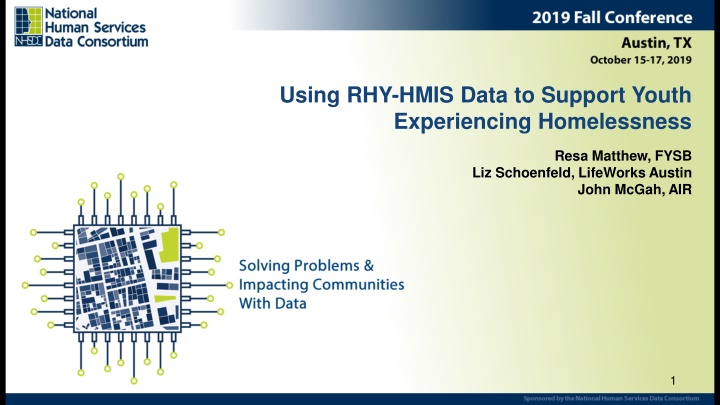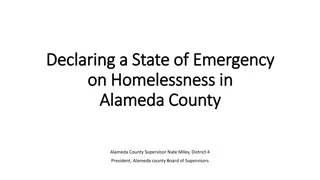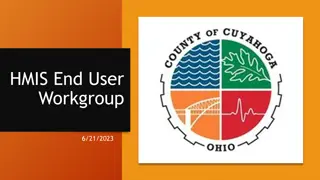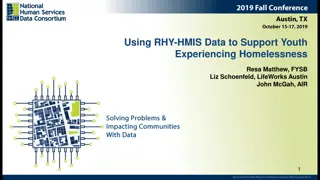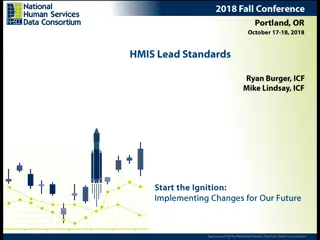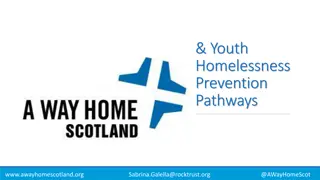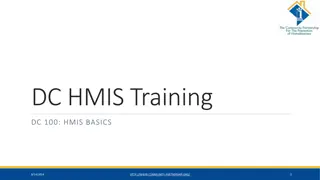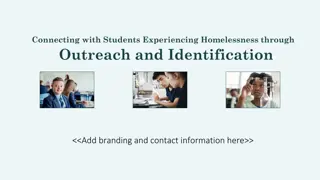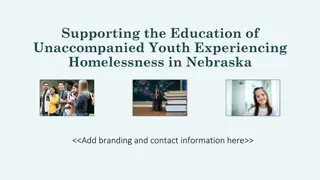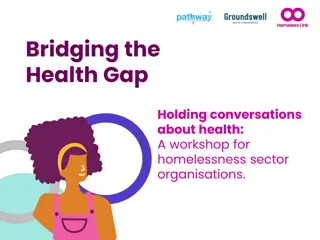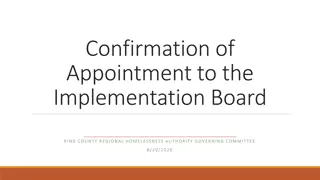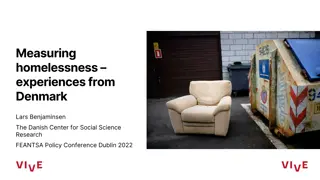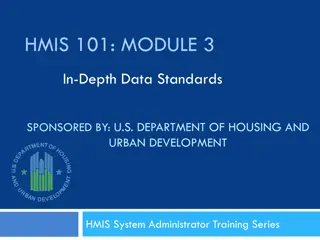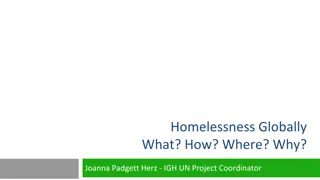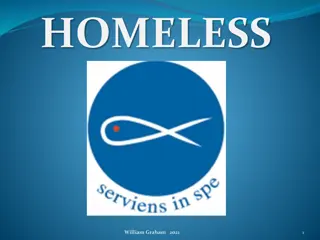Leveraging RHY-HMIS Data for Youth Experiencing Homelessness
Utilizing RHY-HMIS data to support homeless youth, this presentation covers program tenets, funding streams, uses of data according to legislative requirements, and data collection protocols, emphasizing the importance of trauma-informed, culturally sensitive services for young individuals in need.
Download Presentation

Please find below an Image/Link to download the presentation.
The content on the website is provided AS IS for your information and personal use only. It may not be sold, licensed, or shared on other websites without obtaining consent from the author.If you encounter any issues during the download, it is possible that the publisher has removed the file from their server.
You are allowed to download the files provided on this website for personal or commercial use, subject to the condition that they are used lawfully. All files are the property of their respective owners.
The content on the website is provided AS IS for your information and personal use only. It may not be sold, licensed, or shared on other websites without obtaining consent from the author.
E N D
Presentation Transcript
Using RHY-HMIS Data to Support Youth Experiencing Homelessness Resa Matthew, FYSB Liz Schoenfeld, LifeWorks Austin John McGah, AIR 1
Presenters Resa Matthew, Ph.D. Liz Schoenfeld, Ph.D. John McGah, M.S.P.A. 2
Agenda 3
Runaway and Homeless Youth Program Tenets Young people, because of their age and situation, are urgently in need of shelter/housing and services that are trauma-informed, developmentally and age appropriate and culturally sensitive Services to young people should be developed and provided using a positive youth development approach Services and linkages for youth to make that successful transition to adulthood and obtain self sufficiency Services include life skills, interpersonal skill building, educational advancement, job attainment skills, mental and physical health care, parenting skills, financial planning, and referrals to other needed services 4
RHY Funding Streams Street Outreach Program-Provides street-based aid and prevention services to street youth who have been subjected to or are at risk of sexual exploitation and abuse. Basic Center Program-Addresses the immediate needs of runaway and homeless youth under age 18 by providing an array of services including shelter, food, medical care, and counseling. Transitional Living/Maternity Group Home Program-Provides longer-term residential services to homeless youth ages 16 through 21, including shelter, life skills, educational opportunities, and career counseling. 5
Uses of RHY-HMIS Data Legislative requirement (see RHY Act) FYSB uses RHY-HMIS data to measure the effectiveness of RHY programs, inform the design of future changes, ensure grantees have access to their data, inform funding decisions, and provide information to FYSB Federal Project Officers as part of their grantee monitoring process. As required by the Runaway and Youth Homeless Act, FYSB also uses RHY-HMIS data to report on performance measures for the Congressional Justification budget and inform its biennial Report to Congress. Data upload periods occur twice each year (spring and fall) 6
Data Collection-Consent require consent. RHY-HMIS Data Submission to FYSB does not require consent Data Sharing (of PII) requires consent: of parent/guardian for youth < 18 of youth 18 and older RHY Grantees must also safeguard youth s privacy and confidentiality. RHY-HMIS Data Collection does not 7
BCP: Two Types of Projects Prevention Services Optional for BCP grantees No specified time limit Includes home-based services and other services that prevent a youth from running away. HMIS Project Type: Homelessness Prevention Youth included: All out of shelter youth served face-to-face. Focus: Preventing homelessness; Diverting from shelter; finding a safe and appropriate living situation. Emergency Shelter Required for all BCP grantees Up to 21 days funded by FYSB Additional days may be supplemented by other funding streams HMIS Project Type: Emergency Shelter Youth included: All sheltered youth. Focus: Reunifying with family or finding a safe and appropriate living situation. 11
RHY-HMIS Data- Demographics Basic Center Program Demographic Data 2017 RHY-HMIS N = 31,476 47.2% (14,852) 39.5% (12,435) 1.0% (304) 12.3% (3885) N = 31,476 2.2% (689) 0.8% (264) 28.7% (9,028) 0.6% (179) 46.9% (14,758) 5.4% (1,711) 15.4% (4,847) N = 31,476 66.0% (20,775) 19.0% (5,971) 15.0% (4,730) Transitional Living Program Demographic Data 2017 RHY-HMIS N = 4,856 49.7% (2,413) 38.4% (1,865) 1.5% (65) 9.4% (456) N = 4,856 2.5% (119) 0.6% (28) 36.3% (1,763) 0.5% (24) 41.7% (2,023) 7.7% (375) 10.8% (524) N = 4,856 75.8% (3,682) 14.0% (680) 10.2% (494) GENDER Female Male Transgender Youth/Other Unknown RACE American Indian Asian Black or African American Native Hawaiian or Other Pacific Islander White Multiracial Not Provided ETHNICITY Non-Hispanic/Non-Latino Hispanic/Latino Not Provided 12
RHY-HMIS Data- Demographics Basic Center Program Demographic Data 2017 RHY-HMIS N = 25,328 (Mean=14.8) 8.9% (2,243) 6.4% (1,621) 10.6% (2,694) 13.8% (3,495) 17.8% (4,5056) 19.3% (4888) 19.6% (4,964) 3.6% (918) N/A N/A N/A N = 31,476 68.7% (21,619) 1.0% (305) 1.1% (355) 5.7% (1,787) 1.7% (526) 21.9% (6,887) Transitional Living Program Demographic Data 2017 RHY-HMIS N = 3,783 (Mean=18.8) N/A N/A N/A N/A N/A 5.2% (195) 12.6% (476) 24.3% (920) 24.4% (923) 21.0% (796) 12.5% (473) N = 4,856 75.0% (3,640) 3.1% (152) 2.2% (106) 8.6% (416) 2.0% (95) 9.2% (447) AGE 11 or younger 12 13 14 15 16 17 18 19 20 21 SEXUAL ORIENTATION Heterosexual Gay Lesbian Bisexual Questioning/Unsure Unknown 13
Provider Perspective: LifeWorks LifeWorks is a fearless advocate for youth and families seeking their path to self- sufficiency. We are committed to fearless advocacy, shared accountability, and a relentless focus on real, sustainable, and measurable results for the youth we serve. Target population: Transition-age youth (ages 16 26) Experiencing homelessness Aging out of foster care Pregnant/Parenting Trauma survivors 15
Provider Perspective: LifeWorks Counseling Youth & Adult Counseling Community-Based Counseling Peer Support Community-Based Psychiatry Resolution Counseling Education & Workforce Supported Employment & Education GED/High School Equivalency Pregnancy Prevention Teen Parent Services Preparation for Adult Living classes Housing Street Outreach Emergency Shelter Transitional Living Program Young Parents Program PORT (TH-RRH) Rental Assistance & Homelessness Prevention Rapid Rehousing Permanent Supportive Housing After Care Transition Services 16
Provider Perspective: Whats Working? Data collection process RHY data elements allow for a more nuanced understanding of the population that are served Key data elements include sexual orientation, juvenile justice involvement, and child welfare involvement Keeping service providers in the loop Monthly calls with Youth Program Specialist at FYSB 17
Provider Perspective: Challenges & Opportunities RHY-HMIS Data Dashboard Collection of interim and closing assessments (and aftercare data) Double-data entry Need to ensure clarity, meaningfulness, and usefulness of certain data elements 18
Liz Schoenfeld, Ph.D. LifeWorks Austin Phone: 512-735-2130 E-mail: liz.schoenfeld@lifeworksaustin.org 23
